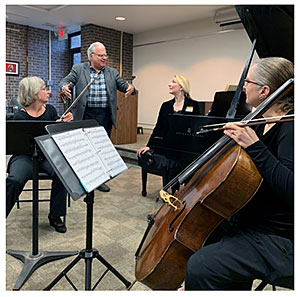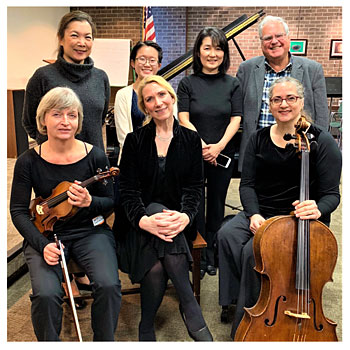Music Educators Association of New Jersey
Serving teachers and students since 1927


The 2019 Teachers' Master Class
Joseph Kalichstein taught a Master Class on March 21st of three performances: solo, trio, and duo. The following comments were made by Mr. Kalichstein during the course of the morning.

Rebecca Eng opened the program performaing the first movement (Allegro maestoso) of Brahms' Sonata No. 3 in F minor, Op. 5.
Mr. Kalichstein began by noting that omposers don't always write in their scores everything they want to hear; what they do write should be considered a guide. In the opening bars, don't let the accents negate the line. Make the accented chords feel majestic. (Ignore the accents as we normally interpret them.) The melodic tension from beat 3 to beat 1 in the following measure would be produced orchestrally by brass or horns. Feel a glissando from beat three descending to beat one. You supply this unbearable tension.
(One thing good about written Spanish is the upside down question mark or the exclamation mark at the beginning of a sentence. Sadly, music notation cannot supply these marks.) Free the sonorous second chord; so play relaxed. Now is the first chance to take a breath. Make one crescendo to 2 then a crescendo to 3. The pulse is going on. You are playing with your eyes. Use a little more pedal – it's the SOUND you want.
Don't think staccato. We are trying to bring back the tension. Use the whole arm. Wait until the last possible moment to bring in the 32nd notes. Rely on your thumb the way blind pianists do. Do not rely on your eye. In an orchestra, this would be violins. Think ahead, but not too much. If you think ahead too much, you don't fully do the job at present. Everything is effort. Be free, don't announce, “I'm going to do an accelerando.” NOT accelerando. Play freely. Play legato so it sings.
Work on thumbs in octaves so the resulting sound is bombastic. Do not worry so much about the upper note. Pretend your thumbs are legato; think less distance between keys. All great pianists use minimum movement. The problem is that string players begin on small instruments, but pianists always play the same instrument. When we start piano as a youngster, an octave is a “boogie man.” Convince yourself that an octave is only eight notes apart. We need to outsmart our fears. If orchestrated, somebody is going to hold this chord. Think “globally.” If you were a movie director, you would use the same camera for all shots, then add another camera. All calm. Use fingers 234 instead of 345. The trick is to put the volume down low, as in old radios, turn down, then gradually turn up the volume. Make sure the thumb barely plays the note. It is the same motif, but played in a grand, expansive, long line. Schumann once wrote about a young man (Chopin?) who composed sonatas, etc, but they all sound like symphonies.

A piano trio composed of Agnes Kwasniewska, violin; Sariah Mourik Johnson, cello; and Cherwyn Ambuter, piano, performed the fourth movement (Allegretto) of Clara Schumann's Piano Trio in G minor, Op.17.
Mr. Kalichstein's comments were directed primarily to the pianist: You are pushing your fingers. Use your wrist. I see too much action from your upper arm. Use a little bit of arm support from the wrist. Do not play marcato when you feel intensity, even if it says forte, and especially in chords when you are in the same register with the strings. It is too bad that, in English, the words tense and intense are similar.
Next the trio played the second movement (Andante espressivo) of Felix Mendelssohn's Piano Trio No. 1 in C minor, Op. 66. Mr. Kalichstein remarked: Early Romantics composed music that was normal, simple, straight from the heart. The late Romantic composers, such as Mahler, were tortured. I ask you to sing the melody. You are a singer telling a story. The piano creates a carpet; be less involved. A great accompaniment is simple. Let the strings emote. Make sure the beginning is in the same tempo. Do not interfere with the basic pulse. Now you showed no emotion, can you voice the chords? Imagine you are conducting: beat two has to be there. You need to feel the eighth notes inside. (Mr. Kalichstein hums the opening to Chopin's 3rd Ballade. Conduct in 3, not in 9.) You look expressive. The
You look expressive. The C already creates the B-flat. Like the cosmos, you can't interfere. The danger is that it sounds like a waltz. The B-flat engenders the A-flat. Always legato – if you need to change position on the keys, move not between the eighth note and the quarter note; change position before the short note. If a bad piano does not repeat a note easily, I will tie it. Your ear should be your guide. I don't want to hear the repeated note in the bass. What is important is the tension between 4 and 5. Don't poke your 5th finger.
The second time you play a piece you are already looking for better fingering. Sometimes I find a new fingering just before a performance. Look (listen) for that sound. Don't let your fingers do the thinking. Can you do legato with the bass also? If you wait for the resolution of a phrase, the music stops. You can't make a heart stop beating if you want to keep living. Refinger the music so the 8th and quarter notes always play legato. I would add more appassionato. Listen, the piano bass is too loud; it interferes with the cello melody. To the cellist: Be a tenor. This is your solo.

A duo composed of Nicole Lee, violin and Naimi Takagi, piano, play the fourth movement (Allegretto poco mosso) of Cesar Franck's Violin Sonata.
Mr. Kalichstein said: Too much sounds the same. You need a dynamic range. You are resting too much on long notes. “Travel, don't sit.” When you come in again, it sounds like “I'm starting the car again.” I want a smooth trip. Always sing the melody. Don't exaggerate the singsong quality. The violinist is dropping – a wonderful pianissimo! Use your 5th finger only; try to get the sound with the 5th finger. To the violinist: Don't pull the bow, that makes the music stop.
There was a French conductor who said: You sound like pregnant angels. (In other words, don’t pull the bow.) The violin sounds too much like you are practicing. Voicing: the chord is too strong for the 5th finger. You are letting the thumb feel it. Mr. K. holds his thumb in the air. Thumbs are “Public Enemy Number One” on all instruments. Thumbs are made for hanging from trees! Don't be democratic. Other fingers have to be less loud. I must hear the melody. I need to feel “I'm home, I'm safe.” I know it is uncomfortable; that's why God gave us a wrist. Move more quickly from this position. You should sound like a horn just came in. Orchestrate.
Suddenly, a fairy with a magic wand wants to play soft and you covered her. Your left hand is too clear; stay like a carpet. To the violinist: the character of staccato is too alive, too loud. To the pianist: it is a little cadenza; don't drive it; don't go anywhere. Balance your dynamics when the violin is playing. Play the thumb of your left hand alone, sing, have nothing tight. Now add your 5th finger, but don't grab the key with your left hand thumb. Release your wrist. Your left hand is a problem; play less loud, I can't hear the violin. You've come home, don't get slower. It is hard because you are grabbing. Think only of the thumb. By the time you get here you are too tired to play the ending.
The audience was enthusiastically engaged with the performances and listened avidly to Mr. Kalichstein's comments. We were delighted to hear all of the musicians who took part in this season's Teachers' Master Class.

Beverly Shea - write-up
Lisa Gonzalez - photos